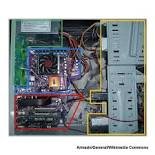Most computers are equipped with a Graphics Processing Unit (GPU) that handles their graphical output, including the 3-D animated graphics used in computer games. The computing power of GPUs has increased rapidly, and they are now often much faster than the computer's main processor, or CPU.
Some BOINC-based projects have applications that run on GPUs. These applications run from 10X to 200X faster than the CPU-only version depending on the application, CPU and GPU in question. We urge BOINC participants to use them if possible. Just follow these instructions:
Check whether your computer has a capable GPU
On Windows, use GPU-Z found here. (note: The listed capabilities of the card may be inaccurate on multi GPU systems.)
On linux, in a console use: lspci | grep VGA
On Macintosh, Select About this Mac from the Apple menu, then click More Info. Under Hardware select Graphics/Displays.
To find out if your NVIDIA GPU is compatible: check NVIDIA's list of CUDA-enabled products. If your GPU is listed here and has at least 256MB of RAM, it's compatible.
ATI GPUs: you need a platform based on the AMD R600 or AMD R700 GPU or later. R600 GPUs are found on ATI Radeon HD2400, HD2600, HD2900 and HD3800 graphics board. R700 GPUs are found on HD4350 to HD4890 graphics boards. Check ATI's list of OpenCL-enabled products to see which GPUs use OpenCL.
Intel GPUs: Currently Ivy Bridge and Haswell are the only Intel CPUs with an OpenCL capable Intel GPU, however future embedded GPUs may also support OpenCL. You will need to install Intel graphics drivers to enable OpenCL support. It's also needed to add a monitor or VGA dummy-plug before the Intel GPU is recognized.
AMD APUs: The AMD Kaveri, Brazos, Kabini and Lynx platforms -Zacate and Kabini for tablet and embedded products and Llano, Trinity and Richland APUs for desktops and laptops- are capable of doing GPU work on their own.
Note: Some projects may have additional requirements. Check with the website of your project of interest for more details.
Things to be aware of
By default, your GPU will be used only when you're not using the computer; otherwise graphical updates become jerky. If you want to use the GPU all the time, you must change your preferences.
You can configure BOINC to not use GPUs when particular applications are running.
You can configure BOINC to not use specific GPUs on a multi-GPU system.
If you have questions or problems related to GPUs, check the BOINCFAQ.
NVIDIA applications on the Mac require NVIDIA driver version 3.0 and Mac OS X version 10.5.6 (Darwin version 9.6.0) or later. For information on downloading and installing CUDA, please see the ReadMe file included with the BOINC Installer for the Mac.
Some newer MacBooks have dual GPUs with automatic switching. Be aware that using the NVIDIA or ATI/AMD GPU while running on batteries may cause faster battery drain; this of course is not an issue when running on AC power.

Hi! I am a robot. I just upvoted you! I found similar content that readers might be interested in:
https://boinc.berkeley.edu/wiki/GPU_computing
@steemcleaners